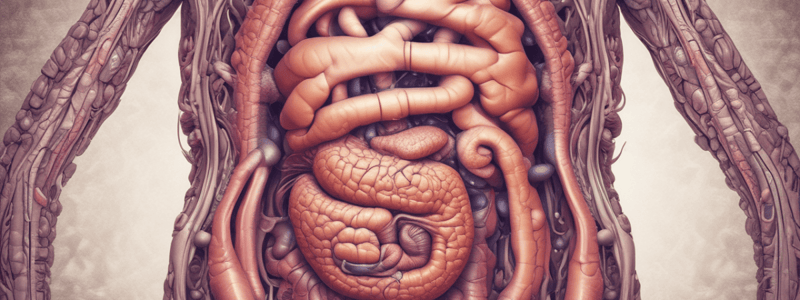Podcast
Questions and Answers
What is the initial form of food that the stomach receives from the esophagus?
What is the initial form of food that the stomach receives from the esophagus?
- Hydrolyzed food
- Gastric juices
- Bolus (correct)
- Chyme
Which process involves the stomach's muscular walls breaking down food?
Which process involves the stomach's muscular walls breaking down food?
- Hydrolysis
- Churning (correct)
- Absorption
- Storage
What is chyme composed of?
What is chyme composed of?
- Unprocessed food from the stomach
- Only gastric enzymes
- A mixture of broken down food and gastric juices (correct)
- Only solid food remnants
How much food can the human stomach store at one time?
How much food can the human stomach store at one time?
What is the function of hydrolysis in the stomach?
What is the function of hydrolysis in the stomach?
What happens to chyme after it is produced in the stomach?
What happens to chyme after it is produced in the stomach?
Which component is NOT part of the stomach's processing functions?
Which component is NOT part of the stomach's processing functions?
When is chyme squirted into the duodenum?
When is chyme squirted into the duodenum?
What is the primary function of parietal cells in the stomach?
What is the primary function of parietal cells in the stomach?
How is pepsin formed from pepsinogen in the stomach?
How is pepsin formed from pepsinogen in the stomach?
What role do mucus cells play in the stomach?
What role do mucus cells play in the stomach?
Which type of nutrient does pepsin specifically break down?
Which type of nutrient does pepsin specifically break down?
What would happen if hydrochloric acid and pepsin were constantly present in the stomach?
What would happen if hydrochloric acid and pepsin were constantly present in the stomach?
What happens to the bolus in the stomach after significant hydrolysis of proteins?
What happens to the bolus in the stomach after significant hydrolysis of proteins?
What is the primary function of the stomach's muscular walls?
What is the primary function of the stomach's muscular walls?
Which component of gastric juice is more acidic than battery acid?
Which component of gastric juice is more acidic than battery acid?
What is chyme, and where is it produced?
What is chyme, and where is it produced?
Why are gastric ulcers common in individuals with insufficient mucus production?
Why are gastric ulcers common in individuals with insufficient mucus production?
Flashcards are hidden until you start studying
Study Notes
Stomach Capacity and Function
- The human stomach can hold between two to four liters of food, equivalent to two Coke bottles.
- It receives a bolus, which is a sphere of food processed in the oral cavity and esophagus.
Key Processes in the Stomach
- The stomach performs three primary functions: receiving food, churning it, and beginning the chemical digestion process.
- Churning helps break down food mechanically through the muscular walls of the stomach.
- Hydrolysis, or enzyme-assisted degradation, occurs to further process the bolus into chyme.
Chyme and Storage
- Chyme is the resultant mixed substance of food after processing, along with gastric enzymes and juices.
- The stomach stores chyme until it's ready to be released into the duodenum (first part of the small intestine) for further digestion.
Gastric Anatomy and Cell Types
- The gastric wall has infoldings that increase surface area and house three main types of cells: parietal cells, chief cells, and mucus cells.
- Parietal cells secrete hydrochloric acid, which is more acidic than battery acid.
Enzyme Secretion
- Chief cells release pepsinogen, the inactive form of the enzyme for protein digestion.
- Hydrochloric acid activates pepsinogen into pepsin, which hydrolyzes protein in food by breaking peptide bonds.
Protection Against Self-Digestion
- Continuous presence of pepsin and hydrochloric acid could cause stomach tissue degradation; thus, mucus cells are crucial.
- Mucus cells secrete mucin, providing a protective coating that prevents gastric ulcers by shielding the stomach lining.
Summary of Stomach Functions
- The stomach churns food physically and chemically, primarily breaking down proteins with pepsin.
- Only proteins are hydrolyzed in the stomach, resulting in chyme ready for transfer to the duodenum for continuing digestion.
Studying That Suits You
Use AI to generate personalized quizzes and flashcards to suit your learning preferences.




